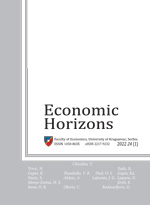
THE JOURNAL IS PUBLISHED
THREE TIMES A YEAR
in April, August and December
Miroslav Todorović, Đorđe Kaličanin and Aleksandra Nojković
Faculty of Economics, University of Belgrade, Belgrade, the Republic of Serbia
A large number of acronyms which indicate diff erent performance metrics, such as EBIT (Earnings Before Interest And Taxes), EBITDA (Earnings Before Interest, Taxes, Depreciation, And Amortization), ROIC (Return On Invested Capital), NPV (Net Present Value), EVA (Economic Value Added), IRR (Internal Rate Of Return), ROE (Return On Equity), ROA (Return On Assets) etc. are in use nowadays. In practice, managers cannot and do not want to apply all of these metrics and managers’ choice does not necessarily rely on what theory emphasizes as their advantages and disadvantages. We surveyed 64 CFOs in order to explore the corporate practice in the Republic of Serbia. The DCF-based capital budgeting metrics are dominant compared to the traditional metrics, and the one that is used the most is the profi tability index, only to be followed by the IRR and the NPV. The Payback Period is yet frequently used. The earnings-based corporate performance metrics are still the most important. However, the presence of EVA and balanced scorecard is not negligible. Large companies use them signifi cantly more than small companies. The orientation towards EVA and balanced scorecard increases with the internationalization of a fi rm as well. Finally, companies using sophisticated capital budgeting metrics are prone to using sophisticated corporate performance metrics.
Keywords:
JEL Classification:
Since March 2015, the Journal is indexed in DOAJ
Since November 2013, the Journal is indexed in ProQuest – ABI/INFORM
Since October 2013, the Journal is indexed in Cabell’s Directories
Since September 2013, the Journal is indexed in Index Copernicus Journals Master List 2012
Since March 2013, the Journal has been evaluated and accepted for listing in EconLit (American Economic Association Publications)
Since January 2013, the Journal has been included into EBSCO’s databases
Since November 2012, the Journal has been included into Ulrich’s Periodicals Directory
Since March 2015, the Journal is indexed in DOAJ
Since November 2013, the Journal is indexed in ProQuest – ABI/INFORM
Since October 2013, the Journal is indexed in Cabell’s Directories
Since September 2013, the Journal is indexed in Index Copernicus Journals Master List 2012
Since March 2013, the Journal has been evaluated and accepted for listing in EconLit (American Economic Association Publications)
Since January 2013, the Journal has been included into EBSCO’s databases
Since November 2012, the Journal has been included into Ulrich’s Periodicals Directory